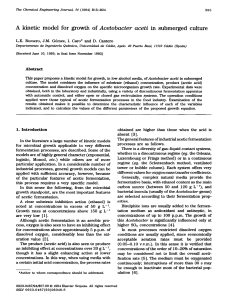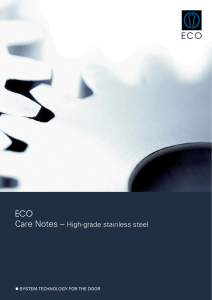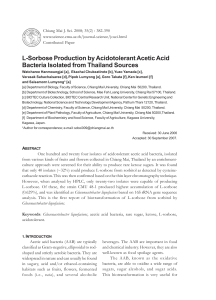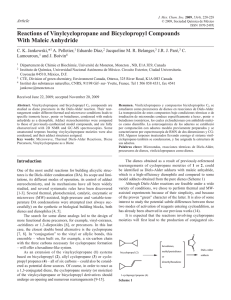Acetic Anhydride
Anuncio
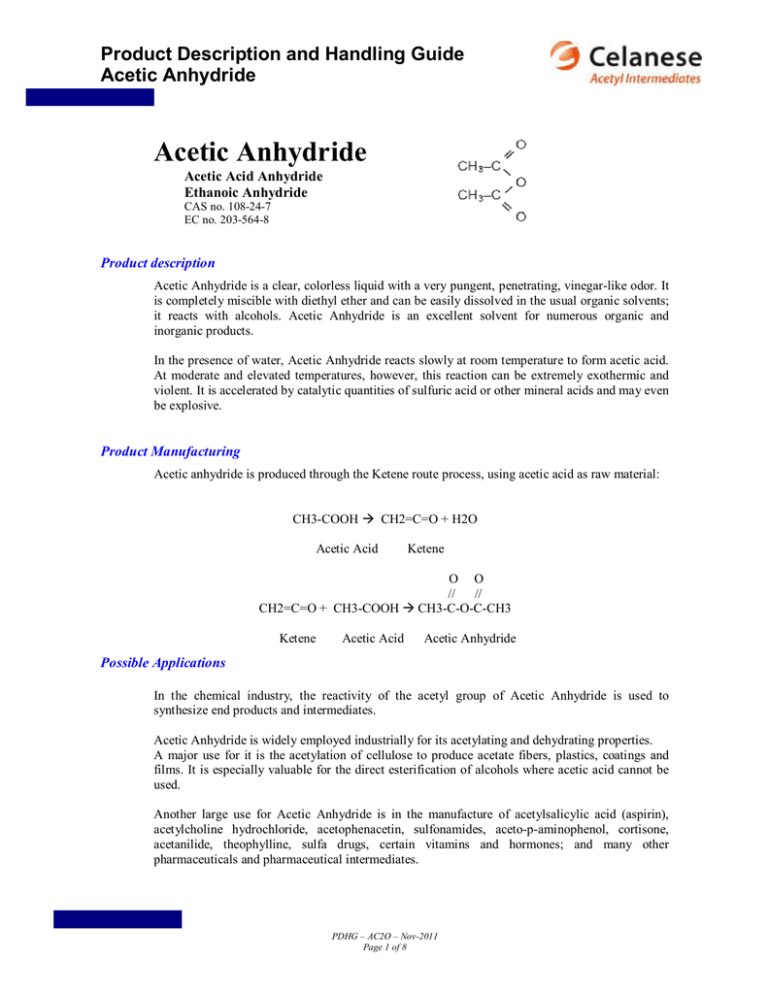
Product Description and Handling Guide Acetic Anhydride Acetic Anhydride Acetic Acid Anhydride Ethanoic Anhydride CAS no. 108-24-7 EC no. 203-564-8 Product description Acetic Anhydride is a clear, colorless liquid with a very pungent, penetrating, vinegar-like odor. It is completely miscible with diethyl ether and can be easily dissolved in the usual organic solvents; it reacts with alcohols. Acetic Anhydride is an excellent solvent for numerous organic and inorganic products. In the presence of water, Acetic Anhydride reacts slowly at room temperature to form acetic acid. At moderate and elevated temperatures, however, this reaction can be extremely exothermic and violent. It is accelerated by catalytic quantities of sulfuric acid or other mineral acids and may even be explosive. Product Manufacturing Acetic anhydride is produced through the Ketene route process, using acetic acid as raw material: CH3-COOH à CH2=C=O + H2O Acetic Acid Ketene O O // // CH2=C=O + CH3-COOH à CH3-C-O-C-CH3 Ketene Acetic Acid Acetic Anhydride Possible Applications In the chemical industry, the reactivity of the acetyl group of Acetic Anhydride is used to synthesize end products and intermediates. Acetic Anhydride is widely employed industrially for its acetylating and dehydrating properties. A major use for it is the acetylation of cellulose to produce acetate fibers, plastics, coatings and films. It is especially valuable for the direct esterification of alcohols where acetic acid cannot be used. Another large use for Acetic Anhydride is in the manufacture of acetylsalicylic acid (aspirin), acetylcholine hydrochloride, acetophenacetin, sulfonamides, aceto-p-aminophenol, cortisone, acetanilide, theophylline, sulfa drugs, certain vitamins and hormones; and many other pharmaceuticals and pharmaceutical intermediates. PDHG – AC2O – Nov-2011 Page 1 of 8 Product Description and Handling Guide Acetic Anhydride Acetic Anhydride is also used to produce acetyl ricinoleates, triacetin, acetyl tributyl citrate, and other plasticizers. Triacetic glycerol esters are used as plasticizers in the plastics and paint industry, as fixatives in perfumery and as solvents for fungicides and basic dyes. Acetylated fatty acid monoglycerides and acetylated animal and vegetable fats are used as additives and auxiliaries in the food industry. In this connection, the relevant statutory food regulations must be observed. Another chemical use is in the manufacture of acetyl peroxide. Acetic Anhydride is also used as an intermediate in the manufacture of explosives, weed killers and in the chemical treatment of papers and textiles Physical Properties Typical Properties Unit Boiling point at 1 Atm. (1013 hPa) °C 1.12 x 10 -3 Coefficient of Thermal Expansion at 20 °C Critical Pressure Critical Temperature Dielectric Constant at 20 °C Evaporation rate (n-Butyl Acetate = 1) Heat of Vaporization at 20 °C at 30 °C at 50 °C Liquid Heat Capacity at 20 °C at 30 °C at 50 °C Liquid Thermal Conductivity at20 °C at 30 °C at 50 °C Melting temperature Molar mass Solubility in water Surface Tension at 20°C at 30°C at 50 °C Vapor density (Air =1) PDHG – AC2O – Nov-2011 Page 2 of 8 139.5 Kg/cm2 °C BTU/lb BTU/lb BTU/lb BTU/lb/°F BTU/lb/°F BTU/lb/°F BTU/ft/sec/°F BTU/ft/sec/°F BTU/ft/sec/°F °C g/mol dynes/cm dynes/cm dynes/cm 40.8 332.8 20.5 0.46 205.7 203.0 197.6 0.436 0.448 0.472 2.65 x 10-5 2.62 x 10-5 2.54 x 10-5 – 83.55 102.09 hydrolyses 32.7 31.2 28.3 3.5 Product Description and Handling Guide Acetic Anhydride Acetic Anhydride - Liquid Density (g/cm3) °F 32 41 50 59 68 77 86 95 104 113 122 °C 0 5 10 15 20 32 41 50 59 68 25 30 35 40 45 50 77 86 95 104 113 122 1.1100 Density (gr/cm3) 1.1000 1.0900 1.0800 1.0700 1.0600 1.0500 1.0400 Liquid Density (g/cm³) °C 0 5 10 15 20 25 30 35 40 45 50 1.1051 1.0991 1.0932 1.0872 1.0811 1.0751 1.0690 1.0628 1.0567 1.0505 1.0442 °F Acetic Anhydride - Vapor Pressure (Kg/cm2) °C 0 5 10 15 20 32 41 50 59 68 25 30 35 40 45 50 77 86 95 104 113 122 Vapor Pressure (Kg/cm2) 0.04 0.03 0.03 0.02 0.02 0.01 0.01 °F 32 41 50 59 68 77 86 95 104 113 122 °C 0 5 10 15 20 25 30 35 40 45 50 Vapor Pressure 2 (Kg/cm ) hPa 0.001 0.002 0.002 0.003 0.005 0.007 0.009 0.013 0.017 0.022 0.029 1.1 1.6 2.3 3.3 4.7 6.6 9.1 12.3 16.5 22.0 28.8 0.00 °F Acetic Anhydride - Liquid Viscosity (centipois) °C 0 5 10 15 20 25 30 35 40 45 50 Liquid Viscosity (centipois) 1.3 1.2 1.1 1.0 0.9 0.8 0.7 0.6 0.5 0.4 32 41 50 59 68 77 86 95 104 113 °F 32 41 50 59 68 77 86 95 104 113 122 °C 0 5 10 15 20 25 30 35 40 45 50 Liquid Viscosity (centipoise or mPa.s) 1.23 1.13 1.05 0.97 0.91 0.85 0.79 0.74 0.70 0.65 0.62 122 °F Data are intended for the purpose of product description and are not the subject of continuous monitoring. Further physical properties and characteristic data as well as information on safety and handling are listed in the material safety data sheet and the sales specifications. Please consult www.celanese.com PDHG – AC2O – Nov-2011 Page 3 of 8 Product Description and Handling Guide Acetic Anhydride Chemical Reactions The reactions of Acetic Anhydride are those of a typical acid anhydride. 1. Acetylation COONa C 6 H 4 CH 3 NH 2 + (CH 3CO ) 2 O CH 3 → C 6 H 4 CH 3 NHCOCH 3 + CH 3COOH 2. Conversion into acids and acid derivates (a) Hydrolysis into acetic acid (CH 3 CO ) 2 O + H 2 O → 2CH 3 COOH (b) Ammonolysis into acetamide (CH 3CO ) 2 O + 2 NH 3 → CH 3CONH 2 + CH 3COONH 4 (c) Alcoholysis into esters (CH 3 CO ) 2 O + CH 3 OH → CH 3 COOCH 3 + CH 3 COOH 3. Formation of ketones by Friedel-Crafts acylation (CH 3CO ) 2 O + ArH AlCl3 → CH 2 COAr + CH 3COOH LewisAcid 4. Condensation Reactions (Perkin) C 6 H 5CHO + (CH 3 CO) 2 O CH3COONa → ∆ C 6 H 5 CH = CHCOOH + CH 3COOH Shelf life The shelf life of Acetic Anhydride is one year. The shelf life dates from the day of packaging for small containers; for bulk product, it is the day of loading. This period is in general applicable to material stored under recommended conditions (see Storage and Handling sections). When product exceeds its shelf life or storage deviates from the recommended conditions, periodic monitoring may be required to verify quality status of the product. Storage Air1,2 or Dry Nitrogen3 Ambient Atmospheric Outside, detached tanks Cool, dry, well ventilated area Recommended Blanketing Recommended Temperature Recommended pressure Bulk Quantities Small Containers 1. Refer to NFPA #77 “Static Electricity” for proper electrical grounding procedures. 2. See the National Fire Protection Agency (NFPA) #30 “Flammable and Combustible Liquids Code” and consult with qualified fire protection specialists to determine specific storage tank design requirements. 3. Blanketing may be used to retain quality in long-term storage conditions. PDHG – AC2O – Nov-2011 Page 4 of 8 Product Description and Handling Guide Acetic Anhydride Handling o Thoroughly review Material Safety Data Sheet before handling product. o Protect small containers from physical damage. Keep containers closed when not in use. Open containers slowly to allow any excess pressure to vent. o Keep away from heat, sparks, flame or other sources of ignition. Use spark-resistant tools. o See the National Fire Protection Agency (NFPA) #30 “Flammable and Combustible Liquids Code” and consult with qualified fire protection specialists to determine specific storage tank design requirements. o Use proper electrical grounding and bonding procedures when loading, unloading and transferring. Refer to the National Fire Protection Agency (NFPA) #77 “Recommended Practice for Static Electricity” for proper electrical grounding procedures. o Electrical equipment and circuits in all storage and handling areas must conform to requirements of national electrical code (Articles 500 and 501) for hazardous location. o Blanketing may be used to retain quality in long-term storage conditions. o For further information on safety and handling, please use the following link: http://www.celanese.com/msds/ Packaging The following containers are suitable for handling and transportation of Acetic Anhydride: • DOT 111A100W1 or 111A60ALW1 Tank Cars • DOT MC 307 or DOT 407 Tank Trucks • UN 1H1/Y1.9/150 55-Gallon High Density Polyethylene Drums • IMO 1 ISO Tank • Ship Tank and Barge Acetic Anhydride is available from Celanese Chemicals as bulk material PDHG – AC2O – Nov-2011 Page 5 of 8 Product Description and Handling Guide Acetic Anhydride Materials of Construction for Storage and Transportation. Unit / element 1. 2. 3. 4. Acceptable Material Alternate Material Tank Piping Valves Pumps Relief Valves Stainless Steel1 Stainless Steel1 Stainless Steel1 Stainless Steel1 Stainless Steel1 Aluminum2 Aluminum2 Aluminum2 – – Gaskets PTFE4 Butyl Rubber Pump Seals Single Mechanical Seal: Stainless Steel / Hastelloy C-276 metallic components, Kalrez O-rings – Valve Packing Pipe End Connections PTFE4 Welded and flanged system Heat Exchanger Hoses Product side: Stainless Steel1 Stainless Steel1 – Threaded with PTFE4 tape thread lubricant – Tank Truck Stainless Steel1 Tank Car Stainless Steel1 ISO Tank Stainless Steel1 Aluminum2 Lined Carbon Steel3 – Barge Stainless Steel1 – Ship Tank Stainless Steel1 – Butyl Rubber, Hard Natural Rubber Aluminum2 Type 304 or 316 Stainless Steel Use 3000, 5000, 6000 series Aluminum when temperature does not exceed 120 oF (49 oC). Lining refers to high baked phenolic resin. Polytetrafluoroethylene For further information on safety and handling, please use the following link: http://www.celanese.com/msds/ PDHG – AC2O – Nov-2011 Page 6 of 8 Product Description and Handling Guide Acetic Anhydride Guidelines Chemical Inventory Status The substance is listed in the following chemical inventories: Chemical Inventory Status AICS DSL NDSL IECSC EINECS ELINCS ENCS ISHL KECI NZIoC PICCS TSCA (Australia) (Canada) (Canada) (China) (Europe) (Europe) (Japan) (Japan) (Korea) (New Zeeland) (Philippines) (USA) Listed Comment X X X X X X X X X X EC-No.: 203-564-8 Japanese ECNS Number (2)-690 Japanese ISHL Number (2)-690 Korean ID Number: KE-00017 § REACh Celanese is aware of the obligations imposed by the European Union legislation REACh (“Registration, Evaluation, Authorization and Restriction of Chemicals”) on EU manufacturers and importers as well as on downstream users. We are obliged to comply with the requirements of the REACh legislation relating to our European manufacturing facilities, our own imports as well as our obligations as a downstream user in the European chemical industry. Should you require additional information, please contact Celanese at [email protected] • BSE/TSE Statement Acetic Anhydride is produced via a totally synthetic process, and no materials of animal origin are used in its manufacture. Therefore, Celanese does not expect this product to pose any risk for the transmission of Bovine Spongiform Encephalopathy (BSE) and Transmissible Spongiform Encephalopathies (TSE). • Genetically Modified Organisms (GMO) Celanese does not use any ingredients of animal or plant origin in the manufacture of Acetic Anhydride. Therefore, we can certify that the supplied Acetic Anhydride contains no genetically modified organisms (GMOs) and no GMOs were used in its production. • Residual Solvents Based on our knowledge of process technology and product characteristics, Celanese Acetic Anhydride is not expected to contain Residual Solvents above the concentration limits specified by the “Tripartite Guideline” (CPMP/ICH/283/95 and CPMP/ICH/1940/00) and by USP-467 (2007). The major impurity is Acetic Acid, which is listed as a class 3 solvent in the mentioned guidelines. Acetic Acid is present at levels below 0.5 wt. %. PDHG – AC2O – Nov-2011 Page 7 of 8 Product Description and Handling Guide Acetic Anhydride • California Proposition 65 List Acetic Anhydride (CAS# 108-24-7) manufactured by Celanese is not listed on the California Proposition 65 list, and based on the impurity profile of the material, does not require require labeling under California Proposition 65. • TSCA Acetic Anhydride (CAS# 108-24-7) manufactured by Celanese complies with all applicable rules or orders under the Toxic Substances Control Act (TSCA). • Kosher Acetic Anhydride manufactured by Celanese is Kosher certified. • Allergens Guide Based on the knowledge of our raw materials and manufacturing process, Celanese Acetyl Intermediates does not expect any of the following allergens and/or intolerance factors to be present in Acetic Anhydride: Egg and egg products, milk and milk products, peanuts or peanut derivatives, tree nuts, fish and fish products, shellfish (crustaceans), molluscs, crabs, sesame seeds and products thereof, celery and products thereof, mustard and products thereof, wheat and wheat derivatives, soya and soy products, cereals containing gluten (i.e. wheat, rye, barley, oats, spelt, kamut or their hybridised strains) and products thereof, buckwheat, lupin, sulphur dioxide and sulphites (at > 10 mg/kg or 10 mg/liter, as SO2). No nutritional data is available for Acetic Anhydride. • Others Celanese Acetic Anhydride contains no melamine, cyanuric acid, or irradiated products, and neither of these materials is included in or produced in the manufacturing process. Celanese Pte Ltd 10 Anson Road, #14-01 / 02, International Plaza Singapore (079903) Tel: (65) 6513-0443 Fax: (65) 6227-8397 Celanese (Shanghai) International Trading Co. Ltd 4560 Jinke Road Zhang Jiang, Pudong New Area Shanghai 201203 P. R. China Tel: +86-21-38619288 Fax: +86-21-38619588 Celanese Chemicals (North America) 1601 West LBJ Freeway Dallas, TX 75234 Tel: 1-972-443-4000 Celanese Chemicals (Europe GmbH) Frankfurter Straße 111 61476 Kronberg im Taunus Deutschland / Germany Tel: +49 69 45009 0 Fax: +49 69 45009 50000 The information contained in this publication is based on our present state of knowledge and is intended to provide general notes on our products and their uses. It should not be construed as promising or guaranteeing specific properties of the products described or their suitability for a particular application. User is solely responsible for determining the suitability of the products for the intended purpose. To the best of our knowledge the information in this publication is accurate; however we do not assume any liability whatsoever for the accuracy and completeness of such information. We strongly recommend that users seek and adhere to our current instructions for handling these products, and to entrust the handling of such products to adequately trained personnel only. Please adhere to the instructions and information contained in the corresponding Material Safety Data Sheets (MSDS) before attempting to process our products. Any existing industrial property rights must be observed. User is solely responsible for investigating and checking the regulatory approval status. The quality of our products is guaranteed under our General Conditions of Sale. PDHG – AC20 - Nov-2011 Superseedes : PDHG Dec 2010 Page 8 of 8

